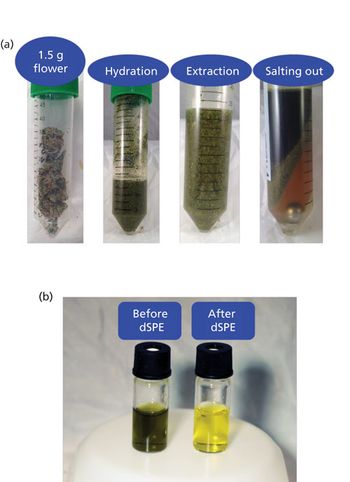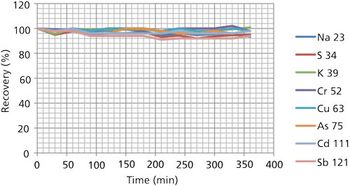
Special Issues
Click the title above to open the LCGC North America May 2017 Advancing the Analysis of Medical Cannabis Supplement, Vol 35 No s5, in an interactive PDF format.

Special Issues
Click the title above to open the LCGC North America May 2017 Advancing the Analysis of Medical Cannabis Supplement, Vol 35 No s5, in an interactive PDF format.

Special Issues
A primary impediment to cannabinoid research is the fact that materials possessing psychoactive Δ-9-tetrathydrocannabinol are considered Schedule I drugs as defined in the U.S. Controlled Substances Act. An alternative source of cannabinoids may be found in hemp oil extracts. Hemp contains a low percentage of Δ-9-tetrathydrocannabinol (THC) by weight but relatively high amounts of non-psychoactive cannabinoids. The liquid chromatography-time of flight mass spectrometry (LC-TOF) method presented herein allows for the accurate, precise and robust speciation, profiling and quantification of cannabinoids in hemp oil extracts and commercial cannabinoid products for research and development laboratories. The method was determined to chromatographically separate 11 cannabinoids including differentiation of Δ-8-tetrahdrocannabinol and THC with excellent linear dynamic range, specificity and sensitivity.

Special Issues
As the legalization of medicinal cannabis continues to sweep across the United States, an urgent need has developed for fast, accurate and efficient analytical testing. In addition to testing for contaminants and potency, there is also interest in the determination of terpene identity and concentration levels present in different strains of cannabis. Terpenes have been shown to have therapeutic uses for treatment of different medical conditions ranging from cancer and inflammation, to anxiety and sleeplessness. It is believed that the combination of terpenes and cannabinoids in cannabis produce a synergistic effect with regards to medical benefits. The traditional testing method for terpenes in plant materials involves a solvent-based extraction followed by GC analysis. In this work, headspace solid phase microextraction (HS-SPME) was used to identify and quantify terpene content in cannabis. The HS-SPME method provided several advantages over solvent extraction in that it provided a cleaner analysis, free of interferences from co-extracted matrix, and was non-destructive to the sample. A cannabis sample of unknown origin was first analyzed qualitatively by HS-SPME and GC-MS. Spectral library matching and retention indices were used to identify 42 different terpenes. Quantitative analysis was then performed for several selected terpenes using spiked samples. Method accuracy was >90%, with reproducibility of

Special Issues
While systems for growing, production and sale of cannabis and cannabis related products are well established, regulation and enforcement of quality and safety testing have lagged behind. However, state governments and private labs are focusing on product safety testing with special emphasis on pesticide analysis. This is partially the result of various product recalls, media attention and concern from patient advocacy groups. We evaluated a modified QuEChERS LC-MS/MS method for analysis of multiresidue pesticides. The AOAC QuEChERS method was used for a reduced 1.5 g amount of plant material and processed with a universal dSPE formulation. LC-MS/MS analysis used constant polarity switching ESI and monitored at least two transitions per analyte. Matrix-matched calibration was used for quantitation and both method and instrument internal standards were used. Analyte recovery validation was performed according to FDA guidelines by testing three matrices at three fortification levels in triplicate for over 200 pesticides. For the large majority of pesticides, in all three matrices and at all three fortification levels, recovery was between 70-120%.

Special Issues
Research scientists in the cannabis field are tasked with validating robust methods that can be seamlessly transitioned into production laboratories. Unlike typical disciplines where controls are easily (and legally) obtained through known manufacturers, analytical chemists working for both consumable vendors as well as cannabis laboratories must do their best to develop methods often without such resources at their disposal. As the industry matures and additional regulations are adopted, the evolution of the pesticide testing subsection continues to be vastly different depending on the jurisdiction one does business in. This creates an interesting challenge for commercial scientists tasked with developing methods that will appeal to a majority of their consumers, while also generating unexpected hurdles to said laboratories once the methods are placed into production. Ace Analytical Laboratory, located in Las Vegas, Nevada, has successfully adopted and validated pesticide testing methods for their cannabis laboratories and has gained valuable insight into how to best work with such a difficult matrix. In conjunction with UCT, LLC, an overview of best practices and method development techniques for pesticide testing in cannabis is discussed below and told from a technical perspective.

Special Issues
This study will focus on an ICP-MS sample preparation procedure and analytical methodology optimized for both toxic and nutritional elements in dried hops, a surrogate for the cannabis family of flowering plants. It will show that the wide dynamic range of the technique allows it to be used for the simultaneous determination of parts per billion (ppb) levels of heavy metals including Pb, As, Cd and Hg, together with high parts per million (ppm) levels of nutritional elements, such as P, Ca, K and Mg.

Special Issues
With the recent legalization of cannabis in several states, there is a growing need for robust, reliable, and cost-effective analytical methods to facilitate routine testing for potency and contaminants. Here we present an LC–MS/MS method that uses the budget-friendly SCIEX Triple Quad 3500 LC–MS/MS system for the simultaneous detection and quantification of cannabinoids, pesticides, and mycotoxins in cannabis products using the Scheduled MRM algorithm.